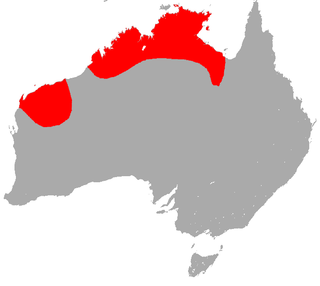
Vespertilionidae is a family of microbats, of the order Chiroptera, flying, insect-eating mammals variously described as the common, vesper, or simple nosed bats. The vespertilionid family is the most diverse and widely distributed of bat families, specialised in many forms to occupy a range of habitats and ecological circumstances, and it is frequently observed or the subject of research. The facial features of the species are often simple, as they mainly rely on vocally emitted echolocation. The tails of the species are enclosed by the lower flight membranes between the legs. Over 300 species are distributed all over the world, on every continent except Antarctica. It owes its name to the genus Vespertilio, which takes its name from a word for bat, vespertilio, derived from the Latin term vesper meaning 'evening'; they are termed as evening bats and once referred to as 'evening birds'.

Gould's long-eared bat is a microbat found in southern regions of Australia. It occurs in eastern Australia, from Queensland to Victoria, and in a smaller isolated range in the south-west of Western Australia.

The desert long-eared bat is a species of vesper bat found in North Africa and the Middle East.

The eastern long-eared bat, species Nyctophilus bifax, is a small flying mammal, a vespertilionid bat. It is found in eastern Australia and Papua New Guinea.

Nyctophilus geoffroyi is a vespertilionid bat, a flying nocturnal mammal found in Australia, The species is relatively common. They have been referred to as the lesser long-eared bat.

The Lord Howe long-eared bat was a vespertilionid bat known only by a single specimen, a skull found on Lord Howe Island in 1972. A mammalian insectivorous species resembling the long-eared Nyctophilus, with an elongated head that is comparatively larger, about which almost nothing is known. The bat may have been casually observed in flight during the twentieth century, but is likely to have become extinct since the island's discovery and occupation. The demise of N. howensis is possibly the result of shipwrecked rats and the owls introduced to control them.

The small-toothed long-eared bat, species Nyctophilus microdon, is a vespertilionid bat. This flying mammal is found only in Papua New Guinea.

Nyctophilus corbeni, commonly known as the south-eastern long-eared bat or Corben's long-eared bat, is a species of bat found in Australia. It occurs in the woodlands of the Murray Darling Basin and adjacent areas.

The pygmy long-eared bat is a vespertilionid bat, found in the north of the Australian continent. An insectivorous flying hunter, they are one of the tiniest mammals in Australia, weighing only a few grams and one or two inches long.
The inland forest bat is a vespertilionid bat that occurs in central and arid regions in Australia. They were first described in 1987, published in a review of poorly surveyed microbat populations. A tiny flying mammal, whose body is around twelve millimetres (½ inch) long, that occupies small cavities in trees and buildings while roosting. The nocturnal activity is foraging for insects, typically moths.
The yellow-lipped cave bat is a vespertilionid bat which only occurs in the Kimberley region of northwest Australia. The bat was first captured at Tunnel Creek in 1958 and a description published nearly twenty years later. Aside from observations of their physical characteristics, a preference for caves, and hunting insects over streams, little is known of the species.
The southern forest bat is a vespertilionid bat found in Australia.

The common sheathtail bat, is a bat in the family Emballonuridae, occurring in northern Australia.

The Arnhem sheath-tailed bat, species Taphozous kapalgensis, is an emballonurid bat found at the Top End of Australia. The species is also referred to as the white-striped sheathtail for the distinguishing marks at the flank, a feature observable beneath the wing when the animal is in flight. Records of the species are rare.

Nyctophilus is a genus of the vespertilionids or vesper bats. They are often termed big-eared bats or long-eared bats, as the length of their ears often greatly exceeds that of the head. This genus occurs in the New Guinean-Australian region.

Setirostris eleryi is a species of small insectivorous bat found in inland eastern Australia. It is the sole species of the molossid genus Setirostris, a name that refers to the coarse bristles on their faces. Earlier common names have referred to this unique feature and the 'free-tail' that is a common feature of the microchiropteran family Molossidae; no single common name emerged during taxonomic revisions that identified what was referred to as the 'bristle-faced freetail'.
The pallid long-eared bat is a species of family Vespertilionidae, a flying mammal endemic to northern Australia. They are also referred to as the northern long-eared bat.

Nyctophilus major, referred to as a western long-eared bat, is a species found in forests and woodlands of Southwest Australia.
Ozimops cobourgianus is a species of molossid bat, insectivorous flying mammals known as freetail bats, which are found in north and west coastal regions of Australia. First described in 1959, the group were later recognised as species Mormopterus cobourgianus and soon placed with a new genus. They are associated with mangrove habitat and roost in the hollows of those trees, and known to seek food there and in eucalypt or melaleuca woodland or other coastal habitat. A smaller bat of genus Ozimops, O. cobourgianus are around fifty millimetres long and weigh six to ten grams. Little is known of their habits.













